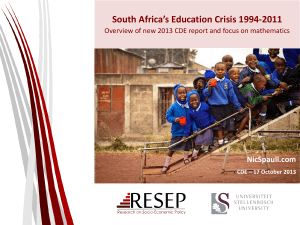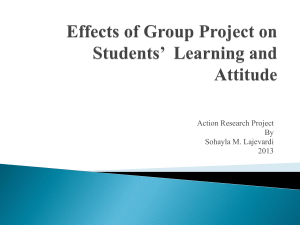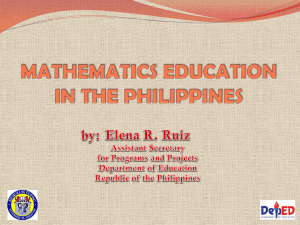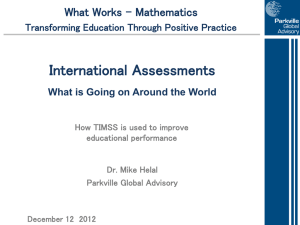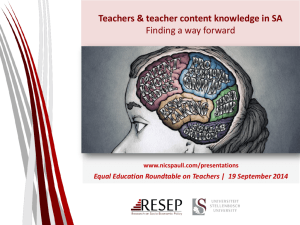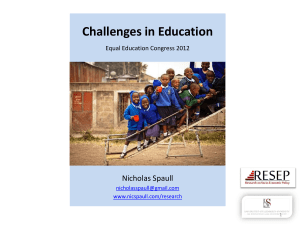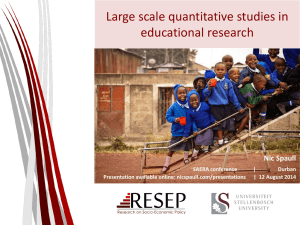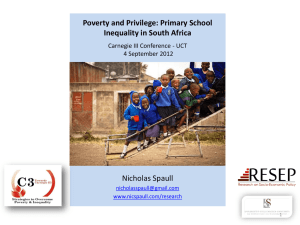South African Teacher Content Knowledge in
advertisement
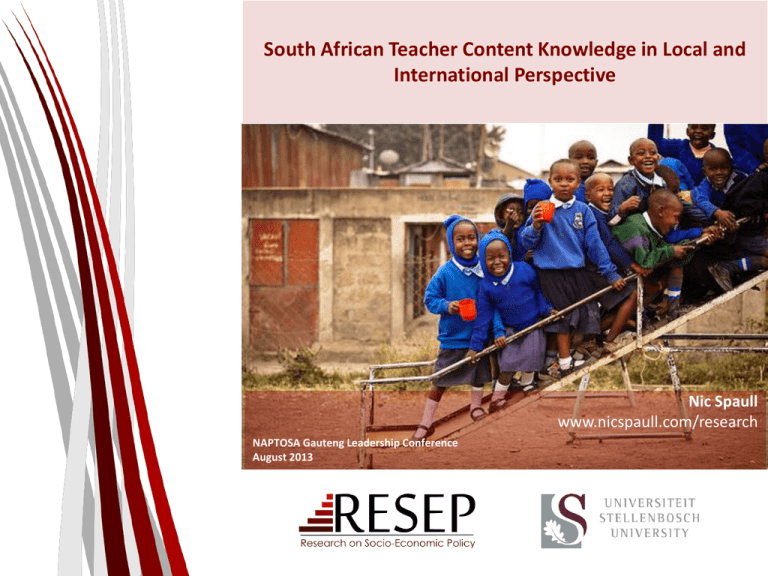
South African Teacher Content Knowledge in Local and International Perspective Nic Spaull www.nicspaull.com/research NAPTOSA Gauteng Leadership Conference August 2013 Overview • Background information to SA education system • South African teachers’ content knowledge – – – – By sub-group Relative to other African countries In specific content areas Relative to Grade 8 international students • Educational outcomes in Gauteng 1995-2011 2 Bird’s-eye view of the South African education system Not all schools are born equal ? Pretoria Boys High School SA public schools? 4 Education and inequality? Quality of education Duration of education Type of education SA is one of the top 3 most unequal countries in the world Between 78% and 85% of total inequality is explained by wage inequality Wages • IQ • Motivation • Social networks • Discrimination High productivity jobs and incomes (17%) • • • Mainly professional, managerial & skilled jobs Requires graduates, good quality matric or good vocational skills Historically mainly white Type Labour Market University/ FET • • • • Vocational training Affirmative action • - High SES background +ECD Minority (20%) Big demand for good schools despite fees Some scholarships/bursaries Unequal society Majority (80%) Low quality secondary school Low SES background Often manual or low skill jobs Limited or low quality education Minimum wage can exceed productivity Low quality primary school Attainment • High quality primary school - Low productivity jobs & incomes • Type of institution (FET or University) Quality of institution Type of qualification (diploma, degree etc.) Field of study (Engineering, Arts etc.) Some motivated, lucky or talented students make the transition Quality • • High quality secondary school cf. Servaas van der Berg – QLFS 2011 6 South African teacher content knowledge Teacher Content Knowledge • Conference Board of the Mathematical Sciences (2001, ch.2) recommends that mathematics teachers need: – “A thorough mastery of the mathematics in several grades beyond that which they expect to teach, as well as of the mathematics in earlier grades” (2001 report ‘The Mathematical Education of Teachers’) • Ball et al (2008, p. 409) – “Teachers who do not themselves know the subject well are not likely to have the knowledge they need to help students learn this content. At the same time just knowing a subject may well not be sufficient for teaching.” • Shulman (1986, p. 9) – “We expect that the subject matter content understanding of the teacher be at least equal to that of his or her lay colleague, the mere subject matter major” 8 South Africa specifically… • Taylor & Vinjevold’s (1999, p. 230) conclusion in their book “Getting Learning Right” is particularly explicit: • “The most definite point of convergence across the [President’s Education Initiative] studies is the conclusion that teachers’ poor conceptual knowledge of the subjects they are teaching is a fundamental constraint on the quality of teaching and learning activities, and consequently on the quality of learning outcomes.” 9 Carnoy & Chisholm (2008: p. 22) conceptual framework 10 Teacher knowledge Teachers cannot teach what they do not know. CK – How Demonizing teachers is popular, but unhelpful to do fractions PCK – “For every increment of performance I demand from you, I have an equal responsibility to provide you with the capacity to meet that expectation. Likewise, for every investment you make in my skill and knowledge, I have a reciprocal responsibility to demonstrate some new increment in performance” (Elmore, 2004b, p. 93). how to teach fractions Student understands & can calculate fractions Background: Data SACMEQ Southern and Eastern African Consortium for Monitoring Educational Quality 14 participating countries SACMEQ II (2000), SACMEQ III (2007) Nationally representative Testing : SACMEQ III: o Gr 6 Numeracy o Gr 6 Literacy o HIV/AIDS Health knowledge South Africa 9071 Grade 6 students 1163 Grade 6 teacher tests 392 primary schools • See SACMEQ website for research Background Data 13 Mathematics teacher content knowledge (SACMEQ 2007) Source: Stephen Taylor 14 Reading teacher reading score by SCHOOL LOCATION of schools SES (SACMEQ 2007) 840 820 BOT KEN 800 LES MOZ 780 NAM SEY 760 SOU SWA TAN 740 UGA ZIM 720 700 Rural urban 15 Mathematics teacher mathematics score by SCHOOL LOCATION (SACMEQ 2007) 950 900 BOT KEN LES 850 MOZ NAM SEY 800 SOU SWA TAN UGA 750 ZIM 700 Rural Urban 16 Mathematics teacher mathematics score by SCHOOL LOCATION (SACMEQ 2007) Rural lower bound confidence interval (95%) Rural upper bound confidence interval (95%) Urban lower bound confidence interval (95%) Urban upper bound confidence interval (95%) 1000 Maths-teacher mathematics score 950 900 KEN 850 ZIM 800 SWA 750 MAL 700 650 SOU LES ZAM NAM TAN SEY UGA BOT MOZ ZAN 600 17 Mathematics teacher mathematics score by QUINTILE of schools SES (SACMEQ 2007) 950 Kenya Mathematics teacher mathematics score 900 South Africa 850 Tanzania Zimbabwe Botswana Kenya Namibia Seychelles Swaziland 800 South Africa Swaziland Tanzania Zimbabwe 750 700 1 2 3 4 5 Quintiles of school SES 18 Reading teacher reading score by QUINTILE of schools SES (SACMEQ 2007) 880 Seychelles 860 Mean Reading teacher reading score 840 South Africa 820 Botswana Kenya 800 Kenya 780 Botswana Namibia 760 Swaziland Namibia Seychelles South Africa Swaziland Tanzania Zimbabwe 740 Tanzania 720 700 1 2 3 4 5 Quintiles of school SES 19 Student and Mathematics teacher’s content knowledge by province (14 countries 115 provinces) SACMEQ 2007 Student and teacher mathematics content knowledge by province (115 provinces across 14 countries) Student maths score Teacher's additional content knowledge Maths teacher content knowledge score 1000 1000 Western Cape 900 900 Gauteng 800 Limpopo 800 Mpumalanga 700 700 600 600 500 500 400 400 300 300 200 200 100 100 0 0 21 Which content areas do South African teachers struggle with? Mathematics teacher performance by content area (SACMEQ III - 2007) Arithmetic operations (10 Qs) Space and shape (8 Qs) Fractions, ratio and proportion (10 Qs) Algebraic logic (9 Qs) Rate of change (7 Qs) 100 90 80 Percentage items correct 70 60 50 40 30 20 10 0 ZAM LES ZAN BOT MAL MOZ NAM SWA SOU ZIM SEY UGA TAN KEN Country 23 Rate of change example SACMEQ III (2007) 401/498 Gr6 Mathematics teachers SACMEQ Maths teacher test Q17 Correct 1 23% 2 22% Quintile 3 38% 4 40% 5 74% Avg 38% 7 Correct answer (7km): 38% of Gr 6 Maths teachers 2 education systems 24 Percentage of Grade 6 mathematics teachers with correct answer on Q17 rate of change example of the SACMEQ III (2007) mathematics teacher test 90% 80% 70% 60% 50% 38% 40% 80% 71% 62% 30% 20% 10% 31% 31% ZAM LES 49% 49% 51% SWA BOT UGA 55% 38% 35% 24% 17% 0% ZAN MOZ MAL SOU NAM TAN SEY ZIM KEN 25 SA Grade 6 Teacher knowledge... Q6: 53% correct (D) Q9: 24% correct (C) English Q9: 57% correct (D) 26 Suggestive of serious deficits in teacher content knowledge 27 What do South African teachers know relative to international students? • Conference Board of the Mathematical Sciences (2001, ch.2) recommends that mathematics teachers need: – “A thorough mastery of the mathematics in several grades beyond that which they expect to teach, as well as of the mathematics in earlier grades” (2001 report ‘The Mathematical Education of Teachers’) Background… • The SACMEQ 2007 teacher test tested Grade 6 Mathematics teachers. • The TIMSS 1995 test tested Grade 8 students from 38 countries in maths and science. • 16 items were common to both tests… 29 South Africa Colombia Philippines Iran, Islamic Rep. Portugal Denmark Iceland Scotland England Norway New Zealand Spain Lithuania Greece Cyprus Germany Latvia (LSS) Sweden ZANZIBAR United States Romania Australia TIMSS Gr8 Avg Belgium (Fr) Ireland Canada Switzerland Netherlands SOUTH AFRICA LESOTHO MOZAMBIQUE Slovenia Austria Israel Russian Federation ZAMBIA Bulgaria France Slovak Republic NAMIBIA Belgium (Fl) MALAWI Czech Republic BOTSWANA SACMEQ AVG. SEYCHELLES Hong Kong SWAZILAND Korea UGANDA TANZANIA Singapore KENYA Average percentage correct on 16 common mathematics items SACMEQ Grade 6 teachers’ average correct response (dark red) and TIMSS Grade 8 average correct response (light red) on 16 items common to Gr 8 TIMSS Mathematics test 1995 and SACMEQ Grade 6 mathematics teachers test 2007 80% 70% 60% 50% 40% 30% 20% 10% 0% 30 Solutions? Possible solution… • The DBE cannot afford to be idealistic in its implementation of teacher training and testing – Aspirational planning approach: All primary school mathematics teachers should be able to pass the matric mathematics exam (benchmark = desirable teacher CK) – Realistic approach: (e.g.) minimum proficiency benchmark where teachers have to achieve at least 90% in the ANA of the grades in which they teach, and 70% in Grade 9 ANA (benchmark = basic teacher CK) • Pilot the system with one district. Imperative to evaluate which teacher training option (of hundreds) works best in urban/rural for example. Rigorous impact evaluations are needed before selecting a program and then rolling it out • Tests are primarily for diagnostic purposes not punitive purposes 32 Accountability stages... • SA is a few decades behind many OECD countries. Predictable outcomes as we move from stage to stage. Loveless (2005: 7) explains the historical sequence of accountability movements for students – similar movements for teachers? – Stages in accountability movements: 1) Setting standards Stage 1 – Setting standards (defining what students should learn), – CAPS – Stage 2 - Measuring achievement (testing to see what students have learned), 2) Measuring achievement – ANA – Stage 3 - Holding educators & students accountable (making results count). 3) Holding accountable – Western Cape performance agreements? “For every increment of performance I demand from you, I have an equal responsibility to provide you with the capacity to meet that expectation. Likewise, for every investment you make in my skill and knowledge, I have a reciprocal responsibility to demonstrate some new increment in performance” (Elmore, 2004b, p. 93). 33 How have educational outcomes changed in Gauteng between 1995 and 2011? Figure 1: Provincial scores for Grade 8 Mathematics, TIMSS 1995*, 1999, 2002 (with 95% confidence interval) 1995* Maths Gr8 1998 Maths Gr8 2002 Maths Gr8 500 450 400 TIMSS Maths score 350 300 250 200 150 100 50 0 LMP ECA NWP KZN MPU FST GAU NCA WCA NATIONAL 35 Figure 5: Provincial average for Grade 9 Mathematics, TIMSS 2002 and TIMSS 2011 (with 95% confidence interval) - TIMSS benchmark used here is the average TIMSS middle-income Grade 8 mathematics mean score 2002 Maths Gr9 2011 Maths Gr9 600 500 400 300 474 200 313 321 333 342 343 350 354 383 433 403 352 100 0 36 Figure 7: Provincial improvement between TIMSS 2002 and TIMSS 2011 - Grade 9 Mathematics (with 95% confidence interval) 120 100 Improvement between Gr9 TIMSS 2002 and TIMSS 2011 80 60 40 55 56 KZN MPU 62 63 63 NWP ECA FST 77 80 LMP GAU 67 20 10 0 -11 WCA NCA National -20 -40 -60 -80 37 Provincial matric pass rates as a percentage of Grade 2 enrolments 10 years earlier Gr2 enrolments - 2001 Gr10 enrolments - 2009 Gr12 enrolments - 2011 Gr12 matric passes - 2011 Matric passes as a % of Gr2 enrolments 10 years earlier 250,000 70% 60% 60% 200,000 51% 50% 39% 150,000 36% 41% 41% 40% 37% 30% 30% 100,000 18% 20% 50,000 10% 0 EC NW FS LP KN MP NC WC GP Gr2 enrolments - 2001 209,954 64,940 54,481 128,831 212,734 76,468 16,885 65,220 115,464 Gr10 enrolments - 2009 150,372 68,078 63,999 171,076 218,528 89,809 21,421 70,451 162,626 Gr12 enrolments - 2011 65,359 25,364 25,932 73,731 122,126 48,135 10,116 39,960 85,367 Gr12 matric passes - 2011 37997 19737 19618 47091 83204 31187 6957 33110 69216 18% 30% 36% 37% 39% 41% 41% 51% 60% Matric passes as a % of Gr2 enrolments 10 years earlier 38 0% Matric performance in Gauteng 2011 Gauteng 24% 26% Drop-out before Grade 12 Fail matric Pass matric Pass with Bachelors 14% 36% 39 Other provinces… Gauteng 24% 26% Drop-out before Grade 12 Fail matric Pass matric Pass with Bachelors 14% 36% 40 Matric pass rates as a percentage of Grade 2 enrolments 10 years earlier for selected provinces – see Taylor (2012: p. 9) EC GP KN LP WC 70% 60% 50% 40% 30% 20% 10% 0% Gr12 in 2004 (Gr2 in 1994) Gr12 in 2005 (Gr2 in 1995) Gr12 in 2006 (Gr2 in 1996) Gr12 in 2006 (Gr2 in 1996) Gr12 in 2009 (Gr2 in 1999) Gr12 in 2010 (Gr2 in 2000) Gr12 in 2011 (Gr2 in 2001) EC 12% 14% 15% 14% 13% 16% 18% GP 44% 45% 43% 47% 47% 52% 60% KN 30% 30% 29% 31% 30% 35% 39% LP 30% 34% 31% 33% 24% 36% 37% WC 40% 37% 38% 39% 36% 41% 51% 41 Conclusions 1. Below-basic teacher content knowledge is a binding constraint to progress – Teachers cannot teach what they do not know 2. The average Grade 6 mathematics teacher in South Africa has lower CK than Grade 6 maths teachers from other African countries and lower levels of CK than Grade 8 students from some OECD countries. – Serious problem which needs well-thought out, rigorous, proven ways of improving CK to basic levels 3. Teachers in South Africa have highly variable content knowledge (urban/rural, rich/poor) – High quality teachers in SA are the minority and are highly unequally distributed 4. The Department does not seem to have a credible plan to address the crisis in teacher content knowledge. – Programs should be piloted and evaluated before roll out – Billions have been wasted on ineffective teacher training, partially because the impact of those programs was not proven prior to implementation 5. Of all the nine provinces, Gauteng has improved the most and is most efficient in “converting” Grade 2 enrolments into matric passes 42 Comments, questions and suggestions welcome… • NicholasSpaull@gmail.com • @NicSpaull • www.nicspaull.com/research • www.resep.sun.ac.za 43
